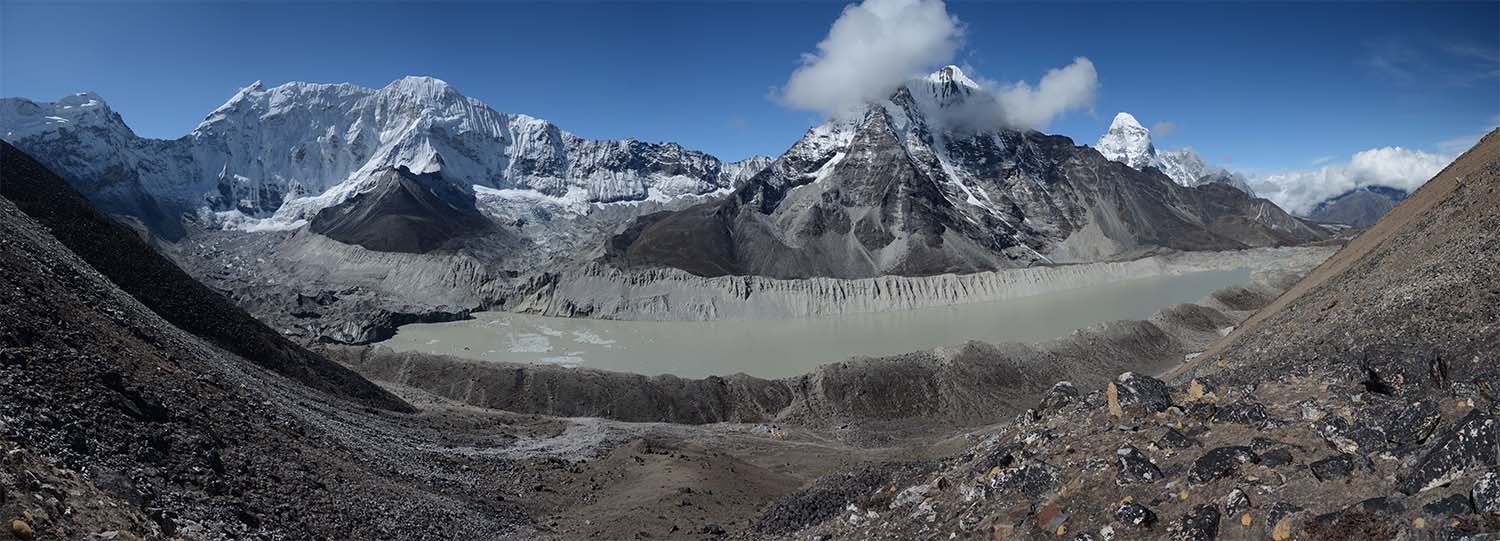
Aug 9, 2016- The district where the ‘top of the world’ lies is divided into two parts—lower Solu and upper Khumbu. The larger river that descends through Khumbu is the Dudh Koshi which originates at Gokyo Lake. The Dudh Koshi meets the Imja Khola, which begins at a glacial lake named Imja Tsho, near Phortse. The Imja Tsho, situated at an elevation of 5,100m, is formed by the waters of the Lhotse Shar, Imja and Amphu glaciers. Other glacier-fed rivers from the Lhotse Nup and Lhotse glaciers meet the Imja Khola near Dingboche. Similarly, the Bhote Koshi that comes from Tibet meets the Dudh Koshi below Namche Bazaar. In this way, there are three major river valleys in Khumbu.
Last month, I was part of a research project titled Science-Based, Community-Driven Approach to Reducing Glacier Lake Outburst Flood Risks in the Nepal Himalaya. Team members in the project, which was funded by the National Science Foundation, included engineers, geographers, anthropologists and graduate students from the US and Nepal. The project is committed to better understanding both the human and physical dimensions of glacial lakes, glacial lake outburst floods (GLOF), impacts on downstream communities and risk reduction strategies.
In 1985, the Bhote Koshi experienced a GLOF from Dig Tsho Lake that washed away a nearly completed hydropower plant, took the lives of four people and destroyed many homes and agricultural fields. The scars of the Langmoche flash flood are still visible in the villages of Thame and Thame Tenga and in the memories of local people. Imja Tsho is considered to be one of the 21 most dangerous glacial lakes in Nepal. It is filled with 75 million cubic metres of water that is held in by a fragile, unconsolidated terminal moraine of loose boulders and rocks. Even though our research team felt that Imja would be safe from ice avalanches from nearby peaks for at least another 15 to 20 years, a devastating GLOF could still be triggered by an earthquake, landslide or moraine collapse, which is why Imja remains in the ‘dangerous’ category.
Climate change denier
It was an astounding trip for our team, as not only were we studying GLOFs and ways to help communities reduce their risk, but we actually saw and filmed one of them from the Lhotse glacier! The flood that we saw is different from a GLOF and is called an ‘englacial conduit flood’, where the hundreds of caves and tunnels within the glacier become filled with water that is suddenly released when the right trigger occurs, in this case, the melting of the ice and sudden release of cave water into other conduits and surficial lakes downstream.
A similar flood occurred in May 2015 and spread panic throughout Khumbu when people started calling their friends and saying that Imja Tsho had burst! The village of Chukung barely escaped then, and it was only saved this year by gabion walls that had been constructed through the initiative of a local NGO, the Khumbu Alpine Conservation Committee. Though the minor flood in the Lhotse Glacier was of concern only to Chukung, the fear of Imja Tsho extends all the way down. One of my colleagues Sonam Phuti Sherpa said that during the Lhotse flood last year, a lodge owner at Dingboche refused to flee saying that if the flood washed away his lodge, he would not be able to repay the loan he took to build it, so there was no sense in running and saving himself.
Even though there have been times when I was sceptical about the existence of climate change, it was at this point, when we could hear the rubble falling as the glacier kept melting, and after we had witnessed an actual glacier flood, that I realised how wrong I had been the whole time. It was a hard fact for me to believe that four decades ago, Imja was still a glacier with a couple of small melt water ponds on its surface. Now, it is 1km long, 0.5km wide and 150m deep, and contains millions of cubic metres of water. How can one be a climate change denier in the face of this?
Commendable work
On this same trip, I was lucky to witness and learn about the project that is currently lowering the water level at Imja Tsho. For someone who had not seen a motor vehicle for two months, it was an astonishing moment to see an excavator working at the terminal moraine outlet of Imja Tsho. The project, which is funded by the UNDP and the Department of Hydrology and Meteorology and implemented by the Nepal Army and Himalayan Research Expeditions, aims to lower the depth of the lake by 3 metres. However, a glaciologist in our team Dr David Rounce said that the lake needed to be lowered by at least 20 metres to reduce the hazards of GLOF significantly. Dr Alton C Byers, who has been working in Khumbu for more than 30 years, said, “reducing the lake by 3 metres may not reduce the hazard significantly, but it will definitely develop the capacity of a Nepali workforce that is capable of working at such high altitudes and difficult terrain and climate.”
Likewise, anthropologist Dr Milan Shrestha said, “Villagers living downstream face a lot of uncertainties and they are fearful of potential GLOF hazards. Although a community-based participatory approach would be more ideal, the villagers are somewhat relieved by the fact that the Army is lowering Imja Tsho by 3 metres.” Though the work initiated and carried out by the UNDP and the Department of Hydrology and Meteorology is commendable, similar work should be extended to other lakes that have been classified as dangerous for GLOF hazards, especially those above highly populated regions and hydropower plants that are being built or are already in existence.
This article was also published in Kathmandu Post National Daily of Nepal on 9th August, 2016.